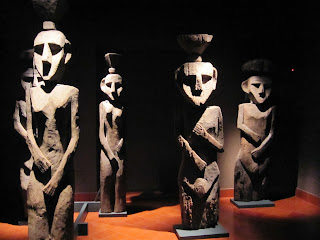We're just back from a weekend visit to Valenica, this is an updated version of our post covering our last trip in May 2010 we flew to Valencia to visit our friends Carlos, Jose and Elen and their 3 month old baby twins. Wow, what a really beautiful city it is, a perfect destination for a short weekend break or the starting point for a longer holiday. It is Spain's third largest city, sitiated in the middle of the huerta, a fertile plain of orange groves and maket gardens. With its warm coastal climate, Valencia is know for its outdoor living and nightlife. Its a perfect city for wandering round with a map in hand, as most of the monuments are in easy walking distance from Plaza del Ayuntamiento, the triangular main square where you will find the town hall.
 |
| The Miguelete, the cathedral's bell tower on Plaza de la Reina |
Valencia is a city full of traditions and festivities. Among these festivities, the most important is the local festivity of the Falles or Las Fallas, well-known worldwide. Among the traditions, the most important is the Water Court or El Tribunal de las Aguas declared Intangible Cultural Heritage of Humanity and the traditional Valencian dish is Paella, originated in the Valencia Community.
The city has a very rich history, which is impressed in the beautiful and extended historic center. Its historical and monumental heritage and the diverse scenic and cultural sites make of the city a great tourist international destination. The most representative Valencian monuments are The Miguelete, the Cathedral, the Serrano's and Quart's Towers, the Lonja de la Seda, and The city of Arts and Sciences. Some of these monuments were declared World Heritage by UNESCO in 1996.
Valencia is also full of museums, among the most representatives we must mention: The Museum of Fine Arts in Valencia, City of Arts and Sciences, Prehistory Museum of Valencia, The cathedral museum, Institute of Modern Art of Valencia. Besides the archeological monuments, Valencia is known as the city of the flowers, it counts with many beautiful landscapes, gardens and parks such as the Turia garden, The Botanic Garden, The Royal Gardens, and The Ayora Garden among others.
 |
| Palau de les Artes Reina Sofia |
Nowadays, Valencia has grown rapidly becoming an economic and financial leader in Spain; this progress is result of the tourism and the construction industry. One of these constructions was the city of Arts and Sciences that was designed by Santiago Calatrava and Félix Candela and constructed by the engineers Alberto Domingo y Carlos Lázaro; it attracts more than 4 million people each year.
 |
| City of Arts and Sciences |
If you've read any of our other posts you'll know that we enjoy sampling the food and drink of the countries and cities that we visit and that tapas is high on our "food heaven" list. We came across
La Taberna Reina, on Plaza de la Reina and highly recommend a visit, we first found it in May 2010 and hunted it down again in November 2012.
 |
| Inside La Taberna Reina |
Another great place to visit is the
Mercado Central, situated in a huge iron, glass and tile Art Nouveau building. It opened in 1928 and is one of the largest and most attractive markets in Europe. Every morning around 350 stalls are filled with an amazing variety of food. We had a great time taking in all that the market had on display and left wishing that we had something similar in our home town in the Netherlands, sadly we don't.
 |
| Valencia's Mercado Central |
As well as enjoying the sights and sounds of the city of Valencia during our May 2010 visit, we also took a small roadtrip to enjoy the surroundings of this beautiful part of Spain.
Lying to the south of the city of Valencia, the Albufera freshwater lagoon is one of the most important nature areas in the Land of Valencia. A slim strip of coastline protects it from the sea, and on this strip of land, sand dunes have formed, plus a curious Mediterranean pine forest growing in sandy soil with rich shrubbery. This area is called the Devesa del Saler, a word derived from a kind of pastureland. Three canals (two natural and a third man-made), connect the lagoon and surrounding wetlands with the sea, and each has its own characteristic flora and fauna.
 |
Albufera
|
We also visited the costal town of
Xabia (Valencian pronunciation) or
Javia (in Spanish),
situated behind a wide bay and sheltered between two rocky headlands, the town has become a very popular small seaside resort and market town.
Our final port of call was Altea, a lovely town with winding streets and whitewashed house fronts. In this case photos tell the story best,
 |
| Whitewashed streets of Altea |
 |
| The end of a wonderful day |
During our most recent visit to Valencia, we stayed in the
Vincci Palace hotel, La Paz 42. The hotel is ideal for exploring the city, close to many of the main attractions. It is about 5 minutes from the
Colon metro station which has a direct line to the airport. The metro ride is €4 per person, wich compared to €25 in a taxi is amazing value, it takes around 20 minutes.The hotel itself is great value, around €80 per night per room, about half the price of a comparable hotel in Madrid. One tip, ask for a room away from the front of the hotel, as the street in front can be quite noisy at night. Enjoy
Valencia!
































































